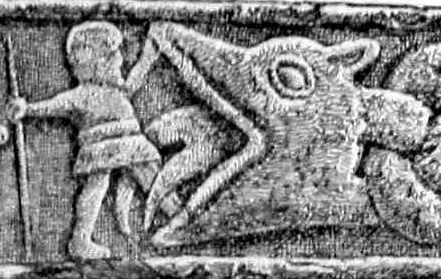Eiríksmál
Eiríksmál is a
in honour of her slain consortAccording to

Structure
Although classified as a Skaldic poem since it deals with a historical figure, it is actually anonymous and in the simple
The poem is cast as a dialogue between Eric, the gods Odin and Bragi, and the legendary hero Sigmund.[4]
Translation from Old Norse
Based on Finnur Jónsson’s Norse edition, English translation by Wikipedia editors.
Verse 1, Odin
"Hvat's þat drauma? hugðumk fyr dag rísa |
Verse 2, Odin
Erum ór heimi hölða vánir |
Out of the world are by me warriors expected, |
Verse 3, Bragi
"Hvat þrymr þar, sem þúsund bifisk |
"What thunders there, as if a thousand were marching, Balder were comingback to Odin's halls."[a] |
Verse 4, Odin
"Heimsku mæla skalat hinn horski Bragi, |
"The wise Bragi should not speak foolishly, |
Verse 5, Odin
"Sigmundr ok Sinfjötli, rísið snarliga |
"Sigmund and Sinfjotli , rise quicklyand go to meet the ruler. Invite him in, if Erik it is, it is he I now expect." |
Verse 6, Bragi, Odin
"Hví 's þér Eireks ván heldr an annarra?" |
"Why do you expect Erik, rather than others?" |
Verse 7, Bragi, Odin

"Hví namt hann sigri þá, es þér þótti snjallr vesa?" |
"Why did you then deprive him of victory, when you thought him so brave?" |
Verse 8, Sigmund
"Heill þú nú Eirekr, vel skalt hér kominn |
"Hail you now, Erik, you will here be greeted well |
Verse 9, Erik
"Konungr 'ru fimm, kennik þér nafn allra, |
There are five kings, I shall teach you the names of them all; |
Notes
Citations
- ^ Fulk 2012, p. 1003.
- ^ Williams 2017, p. 298.
- ^ *"Hákonarmál : Old Norse". www.heimskringla.no. Retrieved 1 March 2022.
- ^ Williams 2017, p. 300.
- ^ Page 2002, pp. 109–111.
Sources
Online
- "Norse Mythology". norse-mythology.org. Retrieved 1 March 2022.
- Finnur Jónsson's edition of Eiríksmál as part of Carmina Scaldica, Udvalg af norske og islandske skjaldekvad ved Finnur Jónsson, G.E.C. Gads Forlag - København 1929, online at heimskringla.no
Books
- Fulk, R. D. (2012). "Anonymous, Eiríksmál". In Whaley, Diana (ed.). Poetry from the Kings’ Sagas 1: From Mythical Times to c. 1035. ISBN 978-2-503-51896-1.
- Page, R. I. (2002). Chronicles of the Vikings - Records, Memorials and Myths. British Museum Press. ISBN 0-7141-2800-7.
- Williams, Thomas (2017). Viking Britain - A History. William Collins Books. ISBN 978-0-00-817195-7.
